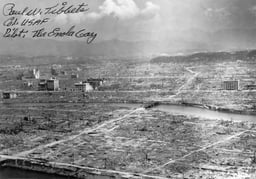Hiroshima
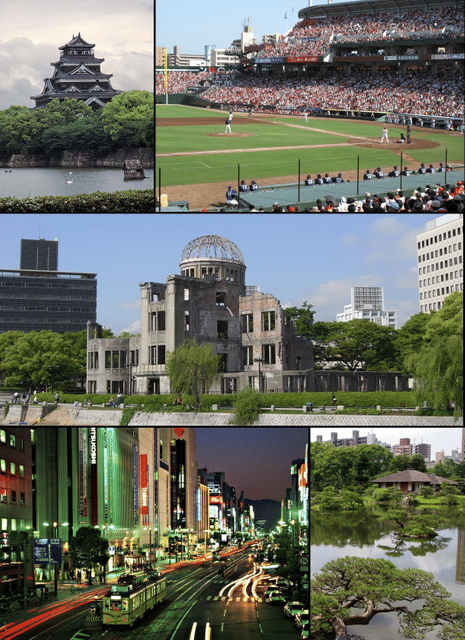
Hiroshima

Hiroshima 広島市 | |||||
|---|---|---|---|---|---|
Designated city | |||||
| City of Hiroshima[1] | |||||
 | |||||
 Location of Hiroshima in Hiroshima Prefecture | |||||
| Coordinates:34°23′N 132°27′E [70] | |||||
| Country | Japan | ||||
| Region | Chūgoku (San'yō) | ||||
| Prefecture | Hiroshima Prefecture | ||||
| Government | |||||
| • Mayor | Kazumi Matsui | ||||
| Area | |||||
| • Designated city | 906.68 km2(350.07 sq mi) | ||||
| Population (June 1, 2019) | |||||
| • Designated city | 1,199,391 | ||||
| • Density | 1,300/km2(3,400/sq mi) | ||||
| • Metro [2] (2015) | 1,431,634 (10th) | ||||
| Time zone | UTC+9 (Japan Standard Time) | ||||
| Tree | Camphor Laurel | ||||
| Flower | Oleander | ||||
| Phone number | 082-245-2111 | ||||
| Address | 1-6-34 Kokutaiji, Naka-ku, Hiroshima-shi 730-8586 | ||||
| Website | www.city.hiroshima.lg.jp [71] | ||||
| Hiroshima | |||||
"Hiroshima" in shinjitai kanji | |||||
| Japanese name | |||||
| Kyūjitai | 廣島 | ||||
| Shinjitai | 広島 | ||||
| |||||

Hiroshima Urban Employment Area
Hiroshima (広島市, Hiroshima-shi, /ˌhɪroʊˈʃiːmə/, also UK: /hɪˈrɒʃɪmə/,[3] US: /hɪˈroʊʃɪmə/, Japanese: [çiɾoɕima]) is the capital of Hiroshima Prefecture in Japan. As of June 1, 2019, the city had an estimated population of 1,199,391. The gross domestic product (GDP) in Greater Hiroshima, Hiroshima Urban Employment Area, was US$61.3 billion as of 2010.[4][5] Kazumi Matsui has been the city's mayor since April 2011.
Hiroshima was founded in 1589 as a castle town on the Ōta River delta. Following the Meiji Restoration in 1868, Hiroshima rapidly transformed into a major urban center and industrial hub. In 1889, Hiroshima officially gained city status. The city was a center of military activities during the imperial era, playing significant roles such as the First Sino-Japanese War, the Russo-Japanese War, and the two world wars.
Towards the end of World War II, Hiroshima is best remembered as the first city targeted by a nuclear weapon, when the United States Army Air Forces (USAAF) dropped an atomic bomb on the city at 8:15 a.m. on August 6, 1945.[6] Most of the city was destroyed, and by the end of the year 90,000–166,000 had died as a result of the blast and its effects. The Hiroshima Peace Memorial (a UNESCO World Heritage Site) serves as a memorial of the bombing.
Hiroshima was rebuilt after the war. It has since become the largest city in the Chūgoku region of western Honshu, the largest island of Japan.
Hiroshima 広島市 | |||||
|---|---|---|---|---|---|
Designated city | |||||
| City of Hiroshima[1] | |||||
 | |||||
 Location of Hiroshima in Hiroshima Prefecture | |||||
| Coordinates:34°23′N 132°27′E [70] | |||||
| Country | Japan | ||||
| Region | Chūgoku (San'yō) | ||||
| Prefecture | Hiroshima Prefecture | ||||
| Government | |||||
| • Mayor | Kazumi Matsui | ||||
| Area | |||||
| • Designated city | 906.68 km2(350.07 sq mi) | ||||
| Population (June 1, 2019) | |||||
| • Designated city | 1,199,391 | ||||
| • Density | 1,300/km2(3,400/sq mi) | ||||
| • Metro [2] (2015) | 1,431,634 (10th) | ||||
| Time zone | UTC+9 (Japan Standard Time) | ||||
| Tree | Camphor Laurel | ||||
| Flower | Oleander | ||||
| Phone number | 082-245-2111 | ||||
| Address | 1-6-34 Kokutaiji, Naka-ku, Hiroshima-shi 730-8586 | ||||
| Website | www.city.hiroshima.lg.jp [71] | ||||
| Hiroshima | |||||
"Hiroshima" in shinjitai kanji | |||||
| Japanese name | |||||
| Kyūjitai | 廣島 | ||||
| Shinjitai | 広島 | ||||
| |||||
History
Sengoku and Edo periods (1589–1871)
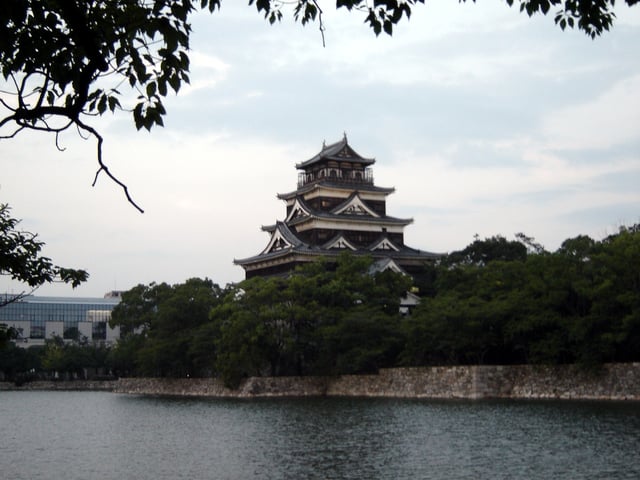
Hiroshima Castle
Hiroshima was established on the delta coastline of the Seto Inland Sea in 1589 by powerful warlord Mōri Terumoto.[7][8] Hiroshima Castle was quickly built, and in 1593 Mōri moved in. Terumoto was on the losing side at the Battle of Sekigahara. The winner of the battle, Tokugawa Ieyasu, deprived Mōri Terumoto of most of his fiefs, including Hiroshima and gave Aki Province to Masanori Fukushima, a daimyō who had supported Tokugawa.[9] From 1619 until 1871, Hiroshima was ruled by the Asano clan.
Imperial period (1871–1939)
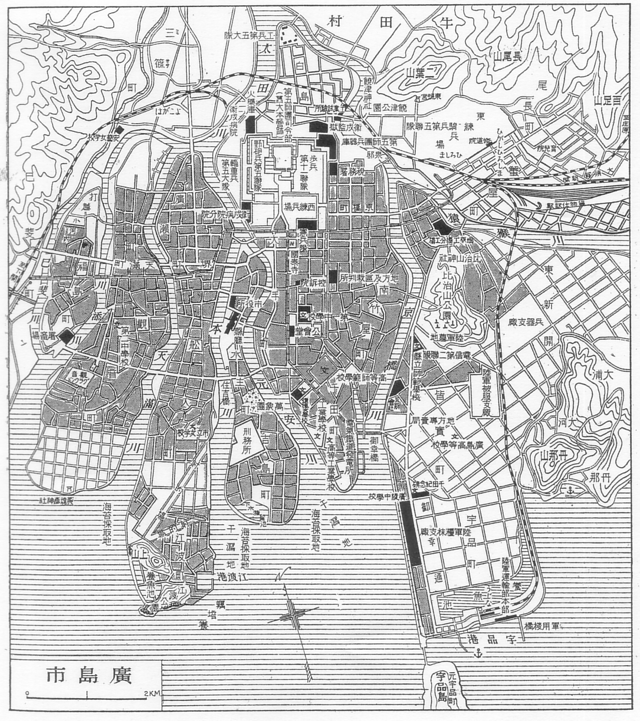
Map of Hiroshima City in the 1930s (Japanese edition)
After the Han was abolished in 1871, the city became the capital of Hiroshima Prefecture. Hiroshima became a major urban center during the imperial period, as the Japanese economy shifted from primarily rural to urban industries. During the 1870s, one of the seven government-sponsored English language schools was established in Hiroshima.[10] Ujina Harbor was constructed through the efforts of Hiroshima Governor Sadaaki Senda in the 1880s, allowing Hiroshima to become an important port city.
The San'yō Railway was extended to Hiroshima in 1894, and a rail line from the main station to the harbor was constructed for military transportation during the First Sino-Japanese War.[11] During that war, the Japanese government moved temporarily to Hiroshima, and Emperor Meiji maintained his headquarters at Hiroshima Castle from September 15, 1894, to April 27, 1895.[11] The significance of Hiroshima for the Japanese government can be discerned from the fact that the first round of talks between Chinese and Japanese representatives to end the Sino-Japanese War was held in Hiroshima, from February 1 to February 4, 1895.[12] New industrial plants, including cotton mills, were established in Hiroshima in the late 19th century.[13] Further industrialization in Hiroshima was stimulated during the Russo-Japanese War in 1904, which required development and production of military supplies. The Hiroshima Prefectural Commercial Exhibition Hall was constructed in 1915 as a center for trade and exhibition of new products. Later, its name was changed to Hiroshima Prefectural Product Exhibition Hall, and again to Hiroshima Prefectural Industrial Promotion Hall.[14]
During World War I, Hiroshima became a focal point of military activity, as the Japanese government entered the war on the Allied side. About 500 German prisoners of war were held in Ninoshima Island in Hiroshima Bay.[15] The growth of Hiroshima as a city continued after the First World War, as the city now attracted the attention of the Catholic Church, and on May 4, 1923, an Apostolic Vicar was appointed for that city.[16]
World War II and the atomic bombing (1939–1945)
During World War II, the Second General Army and Chūgoku Regional Army were headquartered in Hiroshima, and the Army Marine Headquarters was located at Ujina port. The city also had large depots of military supplies, and was a key center for shipping.[17]
The bombing of Tokyo and other cities in Japan during World War II caused widespread destruction and hundreds of thousands of civilian deaths.[18] There were no such air raids on Hiroshima. However, a real threat existed and was recognized. In order to protect against potential firebombings in Hiroshima, school children aged 11–14 years were mobilized to demolish houses and create firebreaks.[19]
On Monday, August 6, 1945, at 8:15 a.m., the nuclear weapon "Little Boy" was dropped on Hiroshima from an American Boeing B-29 Superfortress, the Enola Gay, flown by Colonel Paul Tibbets,[20] directly killing at least 70,000 people, including thousands of Korean slave laborers. Fewer than 10% of the casualties were military.[21] By the end of the year, injury and radiation brought the total number of deaths to 90,000–166,000.[22] The population before the bombing was around 345,000. About 70% of the city's buildings were destroyed, and another 7% severely damaged.
The public release of film footage of the city following the attack, and some of the Atomic Bomb Casualty Commission research the human effects of the attack, were restricted during the occupation of Japan, and much of this information was censored until the signing of the Treaty of San Francisco in 1951, restoring control to the Japanese.[23]
As Ian Buruma observed, "News of the terrible consequences of the atom bomb attacks on Japan was deliberately withheld from the Japanese public by US military censors during the Allied occupation—even as they sought to teach the natives the virtues of a free press. Casualty statistics were suppressed. Film shot by Japanese cameramen in Hiroshima and Nagasaki after the bombings was confiscated. "Hiroshima", the account written by John Hersey for The New Yorker, had a huge impact in the US, but was banned in Japan. As [John] Dower says: 'In the localities themselves, suffering was compounded not merely by the unprecedented nature of the catastrophe ... but also by the fact that public struggle with this traumatic experience was not permitted."[24] The US occupation authorities maintained a monopoly on scientific and medical information about the effects of the atomic bomb through the work of the Atomic Bomb Casualty Commission, which treated the data gathered in studies of hibakusha as privileged information rather than making the results available for the treatment of victims or providing financial or medical support to aid victims.
The book Hiroshima by John Hersey was originally published in article form in the magazine The New Yorker,[25] on 31 August 1946. It is reported to have reached Tokyo, in English, at least by January 1947 and the translated version was released in Japan in 1949.[26] Despite the fact that the article was planned to be published over four issues, "Hiroshima" made up the entire contents of one issue of the magazine.[27][28] Hiroshima narrates the stories of six bomb survivors immediately prior to and four months after the dropping of the Little Boy bomb.[25][29]
Oleander (Nerium) is the official flower of the city of Hiroshima because it was the first to bloom again after the explosion of the atomic bomb in 1945.[30]
Postwar period (1945–present)
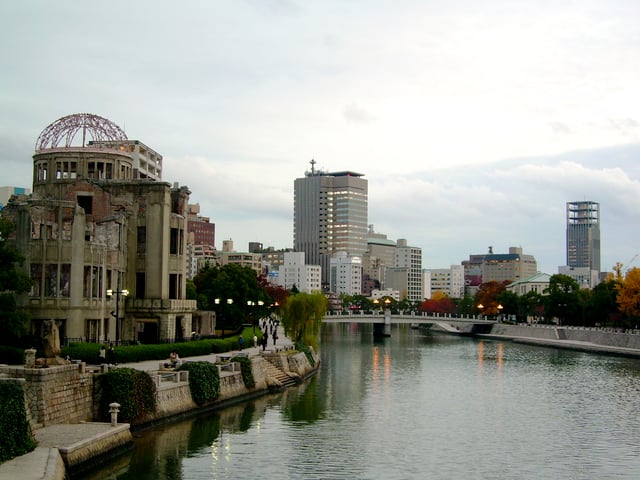
Atomic Bomb Dome by Jan Letzel and modern Hiroshima
On September 17, 1945, Hiroshima was struck by the Makurazaki Typhoon (Typhoon Ida). Hiroshima Prefecture suffered more than 3,000 deaths and injuries, about half the national total.[31] More than half the bridges in the city were destroyed, along with heavy damage to roads and railroads, further devastating the city.[32]
Hiroshima was rebuilt after the war, with help from the national government through the Hiroshima Peace Memorial City Construction Law passed in 1949. It provided financial assistance for reconstruction, along with land donated that was previously owned by the national government and used by the Imperial military.[33]
In 1949, a design was selected for the Hiroshima Peace Memorial Park. Hiroshima Prefectural Industrial Promotion Hall, the closest surviving building to the location of the bomb's detonation, was designated the Genbaku Dome (原爆ドーム) or "Atomic Dome", a part of the Hiroshima Peace Memorial Park. The Hiroshima Peace Memorial Museum was opened in 1955 in the Peace Park.[34]
Hiroshima also contains a Peace Pagoda, built in 1966 by Nipponzan-Myōhōji. Uniquely, the pagoda is made of steel, rather than the usual stone.[35]
Hiroshima was proclaimed a City of Peace by the Japanese parliament in 1949, at the initiative of its mayor, Shinzo Hamai (1905–1968). As a result, the city of Hiroshima received more international attention as a desirable location for holding international conferences on peace as well as social issues. As part of that effort, the Hiroshima Interpreters' and Guide's Association (HIGA) was established in 1992 in order to facilitate interpretation for conferences, and the Hiroshima Peace Institute was established in 1998 within the Hiroshima University. The city government continues to advocate the abolition of all nuclear weapons and the Mayor of Hiroshima is the president of Mayors for Peace, an international mayoral organization mobilizing cities and citizens worldwide to abolish and eliminate nuclear weapons by the year 2020.[36][37]
On May 27, 2016, Barack Obama became the first sitting United States president to visit Hiroshima since the atomic bombing.[38]
Schedule Hiroshima is situated on the Ōta River delta, on Hiroshima Bay, facing the Seto Inland Sea on its south side. The river's six channels divide Hiroshima into several islets.
Geography
Climate
Hiroshima has a humid subtropical climate characterized by cool to mild winters and hot humid summers. Like much of the rest of Japan, Hiroshima experiences a seasonal temperature lag in summer; with August rather than July being the warmest month of the year. Precipitation occurs year-round, although winter is the driest season. Rainfall peaks in June and July, with August experiencing sunnier and drier conditions.
| Climate data for Hiroshima, Hiroshima (1981–2010) | |||||||||||||
|---|---|---|---|---|---|---|---|---|---|---|---|---|---|
| Month | Jan | Feb | Mar | Apr | May | Jun | Jul | Aug | Sep | Oct | Nov | Dec | Year |
| Record high °C (°F) | 18.8 (65.8) | 21.5 (70.7) | 23.7 (74.7) | 29.0 (84.2) | 31.5 (88.7) | 34.4 (93.9) | 38.7 (101.7) | 37.9 (100.2) | 36.9 (98.4) | 31.2 (88.2) | 26.3 (79.3) | 22.3 (72.1) | 38.7 (101.7) |
| Average high °C (°F) | 9.7 (49.5) | 10.6 (51.1) | 14.0 (57.2) | 19.7 (67.5) | 24.1 (75.4) | 27.2 (81.0) | 30.8 (87.4) | 32.5 (90.5) | 29.0 (84.2) | 23.4 (74.1) | 17.4 (63.3) | 12.3 (54.1) | 20.9 (69.6) |
| Daily mean °C (°F) | 5.2 (41.4) | 6.0 (42.8) | 9.1 (48.4) | 14.7 (58.5) | 19.3 (66.7) | 23.0 (73.4) | 27.1 (80.8) | 28.2 (82.8) | 24.4 (75.9) | 18.3 (64.9) | 12.5 (54.5) | 7.5 (45.5) | 16.3 (61.3) |
| Average low °C (°F) | 1.7 (35.1) | 2.1 (35.8) | 4.8 (40.6) | 9.9 (49.8) | 14.7 (58.5) | 19.4 (66.9) | 23.8 (74.8) | 24.8 (76.6) | 20.8 (69.4) | 14.2 (57.6) | 8.5 (47.3) | 3.7 (38.7) | 12.4 (54.3) |
| Record low °C (°F) | −8.5 (16.7) | −8.3 (17.1) | −7.2 (19.0) | −1.4 (29.5) | 1.8 (35.2) | 6.6 (43.9) | 14.1 (57.4) | 13.7 (56.7) | 8.6 (47.5) | 1.5 (34.7) | −2.6 (27.3) | −8.6 (16.5) | −8.6 (16.5) |
| Average precipitation mm (inches) | 44.6 (1.76) | 66.6 (2.62) | 123.9 (4.88) | 141.7 (5.58) | 177.6 (6.99) | 247.0 (9.72) | 258.6 (10.18) | 110.8 (4.36) | 169.5 (6.67) | 87.9 (3.46) | 68.2 (2.69) | 41.2 (1.62) | 1,537.6 (60.54) |
| Average snowfall cm (inches) | 5 (2.0) | 4 (1.6) | 1 (0.4) | 0 (0) | 0 (0) | 0 (0) | 0 (0) | 0 (0) | 0 (0) | 0 (0) | 0 (0) | 3 (1.2) | 12 (4.7) |
| Average snowy days | 8.7 | 7.1 | 2.6 | 0.0 | 0.0 | 0.0 | 0.0 | 0.0 | 0.0 | 0.0 | 0.2 | 4.5 | 23.1 |
| Average relative humidity (%) | 68 | 67 | 64 | 63 | 66 | 72 | 74 | 71 | 70 | 68 | 69 | 69 | 68 |
| Mean monthly sunshine hours | 137.2 | 139.7 | 169.0 | 190.1 | 206.2 | 161.4 | 179.5 | 211.2 | 165.3 | 181.8 | 151.6 | 149.4 | 2,042.3 |
| Source: [39] | |||||||||||||
Wards
Hiroshima has eight wards (ku):
Places of interest
Hiroshima has many interesting places to visit. A popular destination outside the city is Itsukushima Island, also known as Miyajima, which is a sacred island with many temples and shrines. But inside Hiroshima there are many popular destinations as well, and according to online guidebooks, these are the most popular tourist destinations in Hiroshima:[40]
Hiroshima Peace Memorial Museum
The Atomic Bomb Dome
Hiroshima Peace Memorial Park
Mazda Zoom-Zoom Stadium Hiroshima
Hiroshima Castle
Shukkei-en
Mitaki-dera Temple
Hiroshima Gogoku Shrine
Kamiyacho and Hatchobori (A major center in Hiroshima which is a shopping area. It is directly connected to the Hiroshima Bus Center )
Senko-ji Temple (Senko-ji Park)
Other popular places in the city include the Namiki-dōri shopping area.
Demographics
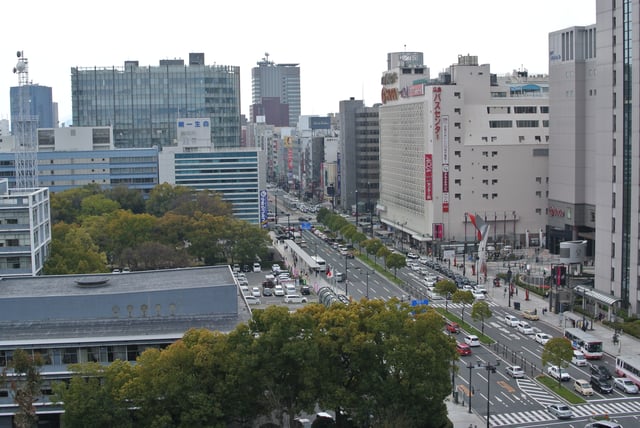
Down town of Hiroshima City
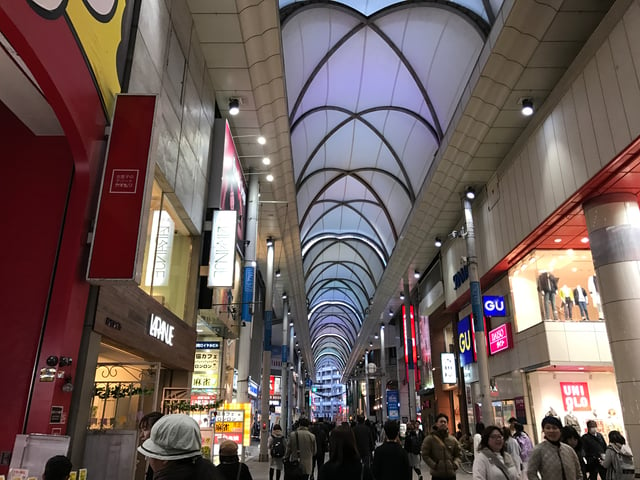
Hondōri Shopping Street
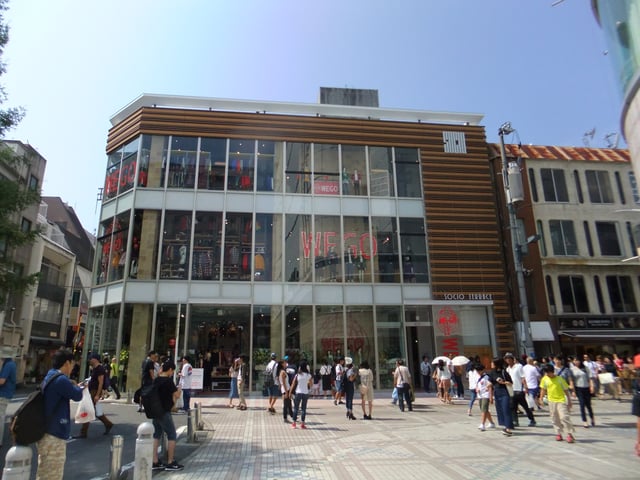
Hiroshima Zero Gate
In 2017, the city has an estimated population of 1,195,327. The total area of the city is 905.08 square kilometres (349.45 sq mi), with a population density of 1321 persons per km².[41]
The population around 1910 was 143,000.[42] Before World War II, Hiroshima's population had grown to 360,000, and peaked at 419,182 in 1942.[43] Following the atomic bombing in 1945, the population dropped to 137,197.[43] By 1955, the city's population had returned to pre-war levels.[44]
Events
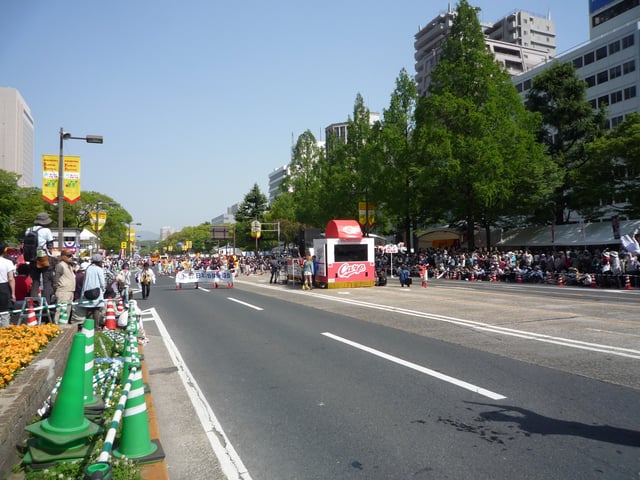
Hiroshima Flower Festival 2011
Hiroshima Flower Festival, May 3–5, Heiwa Odori, Hiroshima Peace Memorial Park
Toukasan, first Friday to Sunday in June, Mikawa-cho, Chuo Dori
Ebisu Festival, November 18–20, Ebisucho, Hacchobori, Chuo Dori
Hiroshima Peace Memorial Ceremony, August 6, Hiroshima Peace Memorial Park
1994 Asian Games
Culture
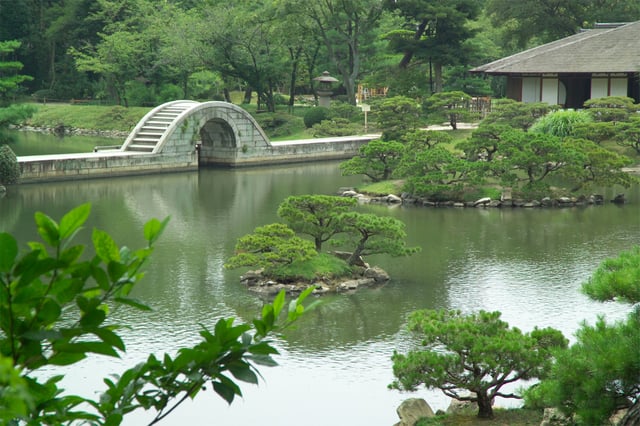
Shukkei-en
Hiroshima has a professional symphony orchestra, which has performed at Wel City Hiroshima since 1963.[45] There are also many museums in Hiroshima, including the Hiroshima Peace Memorial Museum, along with several art museums. The Hiroshima Museum of Art, which has a large collection of French renaissance art, opened in 1978. The Hiroshima Prefectural Art Museum opened in 1968, and is located near Shukkei-en gardens. The Hiroshima City Museum of Contemporary Art, which opened in 1989, is located near Hijiyama Park. Festivals include Hiroshima Flower Festival and Hiroshima International Animation Festival.
Hiroshima Peace Memorial Park, which includes the Hiroshima Peace Memorial, draws many visitors from around the world, especially for the Hiroshima Peace Memorial Ceremony, an annual commemoration held on the date of the atomic bombing. The park also contains a large collection of monuments, including the Children's Peace Monument, the Hiroshima National Peace Memorial Hall for the Atomic Bomb Victims and many others.
Hiroshima's rebuilt castle (nicknamed Rijō, meaning Koi Castle) houses a museum of life in the Edo period. Hiroshima Gokoku Shrine is within the walls of the castle. Other attractions in Hiroshima include Shukkei-en, Fudōin, Mitaki-dera, and Hijiyama Park.
Cuisine
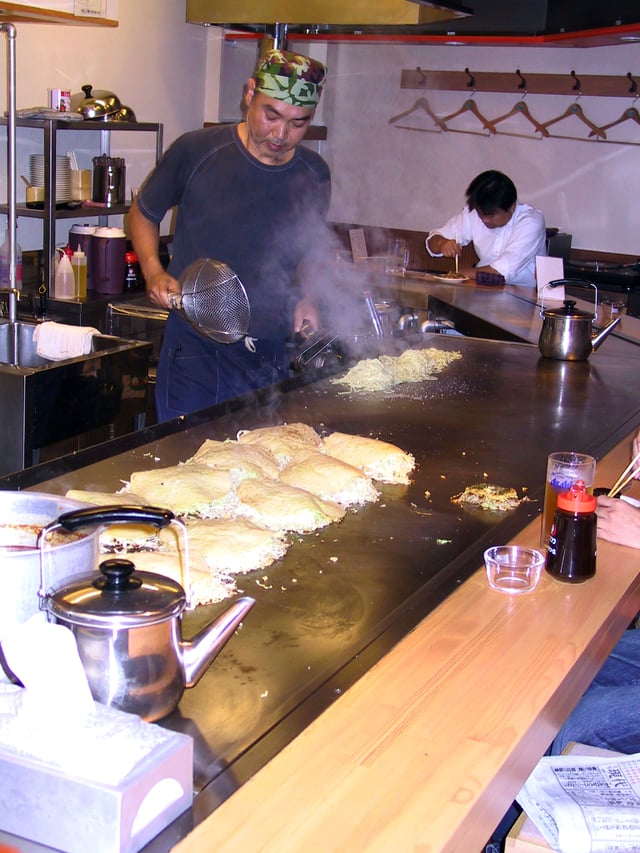
A man making an okonomiyaki at a restaurant in Hiroshima
Hiroshima is known for okonomiyaki, a savory (umami) pancake cooked on an iron plate, usually in front of the customer. It is cooked with various ingredients, which are layered rather than mixed together as done with the Osaka version of okonomiyaki. The layers are typically egg, cabbage, bean sprouts (moyashi), sliced pork/bacon with optional items (mayonnaise, fried squid, octopus, cheese, mochi, kimchi, etc.), and noodles (soba, udon) topped with another layer of egg and a generous dollop of okonomiyaki sauce (Carp and Otafuku are two popular brands). The amount of cabbage used is usually 3 to 4 times the amount used in the Osaka style. It starts out piled very high and is generally pushed down as the cabbage cooks. The order of the layers may vary slightly depending on the chef's style and preference, and ingredients will vary depending on the preference of the customer.
Sports
Hiroshima has several professional sports clubs. The city's main football club are Sanfrecce Hiroshima, who play at the Hiroshima Big Arch. As Toyo Kogyo Soccer Club, they won the Japan Soccer League five times between 1965 and 1970 and the Emperor's Cup in 1965, 1967 and 1969. After adopting their current name in 1992, the club won the J.League in 2012 and 2013. The city's main women's football club is Angeviolet Hiroshima. Defunct clubs include Rijo Shukyu FC, who won the Emperor's Cup in 1924 and 1925, and Ẽfini Hiroshima SC.
Hiroshima Toyo Carp are the city's major baseball club, and play at the Mazda Zoom-Zoom Stadium Hiroshima. Members of the Central League, the club won the Japan Series in 1979, 1980 and 1984. Other sports clubs include Hiroshima Dragonflies (basketball), Hiroshima Maple Reds (handball) and JT Thunders (volleyball).
The Woodone Open Hiroshima was part of the Japan Golf Tour between 1973 and 2007. The city also hosted the 1994 Asian Games, using the Big Arch stadium, which is now used for the annual Mikio Oda Memorial International Amateur Athletic Game. The now-called Hiroshima Prefectural Sports Center was one of the host arenas of the 2006 FIBA World Championship (basketball).
Economy and infrastructure
Health care
Hospitals
Hiroshima City Hospital
Hiroshima City Asa Hospital
Hiroshima City Funairi Hospital
Hiroshima Prefectural Hospital
Hiroshima Red Cross Hospital & Atomic-bomb Survivors Hospital
Hiroshima University Hospital
Japan Post Hiroshima Hospital
JR Hiroshima Hospital
Media
The Chūgoku Shimbun is the local newspaper serving Hiroshima. It publishes both morning paper and evening editions. Television stations include Hiroshima Home Television, Hiroshima Telecasting, Shinhiroshima Telecasting, and the RCC Broadcasting. Radio stations include Hiroshima FM, Chugoku Communication Network, FM Fukuyama, FM Nanami, and Onomichi FM. Hiroshima is also served by NHK, Japan's public broadcaster, with television and radio broadcasting.
Transportation
Air
Hiroshima is served by Hiroshima Airport (IATA: HIJ, ICAO: RJOA), located 50 kilometres (31 mi) east of the city, with regular flights to Tokyo, Sapporo, Sendai, Okinawa, and also to China, Taiwan, Singapore and South Korea.
Trains
JR West San'yō Shinkansen, San'yō Main Line, Kure Line, Geibi Line, Kabe Line
Hiroshima New Transit Line 1
Hiroshima Short Distance Transit Seno Line
Streetcars
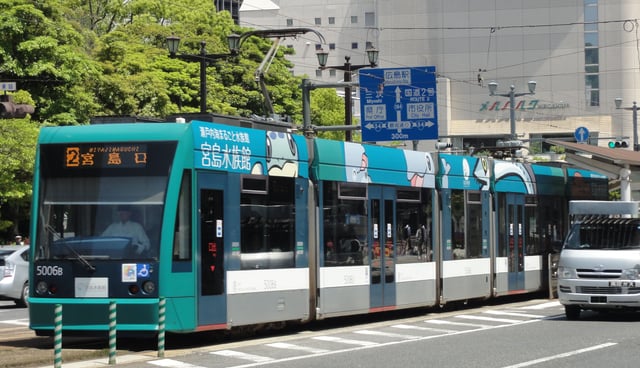
A Hiroshima tram, 2015
Hiroshima is notable, in Japan, for its light rail system, nicknamed Hiroden, and the "Moving Streetcar Museum." Streetcar service started in 1912,[46] was interrupted by the atomic bomb, and was restored as soon as was practical. (Service between Koi/Nishi Hiroshima and Tenma-cho was started up three days after the bombing.[47])
Streetcars and light rail vehicles are still rolling down Hiroshima's streets, including streetcars 651 and 652, which survived the atomic blast and are among the older streetcars in the system. When Kyoto and Fukuoka discontinued their trolley systems, Hiroshima bought them up at discounted prices, and, by 2011, the city had 298 streetcars, more than any other city in Japan.[47]
Hiroden Main Line, Ujina Line, Eba Line, Hakushima Line, Hijiyama Line, Yokogawa Line, Miyajima Line
Automobiles
Hiroshima is served by Japan National Route 2, Japan National Route 54, Japan National Route 183, Japan National Route 261 Japan National Route 433, Japan National Route 487, Japan National Route 488, Hiroshima Prefectural Route 37 (Hiroshima-Miyoshi Route), Hiroshima Prefectural Route 70 (Hiroshima-Nakashima Route), Hiroshima Prefectural Route 84 (Higashi Kaita Hiroshima Route), Hiroshima Prefectural Route 164 (Hiroshima-Kaita Route), and Hiroshima Prefectural Route 264 (Nakayama-Onaga Route).
Tourism
The Japanese city and Perfecture of Hiroshima may have been devastated by the atomic bomb over 73 years ago, but today, this site of the destruction is one of the top tourist destinations in the entire country. Statistics released by the nation's tourist agency revealed that around 363,000 visitors went to the metropolis during 2012, with Americans making up the vast majority of that figure, followed by Australians and Chinese.[48]
Education
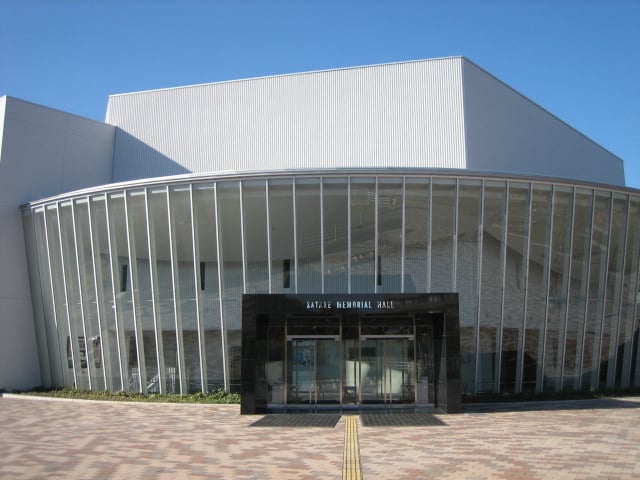
Satake Memorial Hall at Hiroshima University (in Higashihiroshima City)
Hiroshima University was established in 1949, as part of a national restructuring of the education system. One national university was set up in each prefecture, including Hiroshima University, which combined eight existing institutions (Hiroshima University of Literature and Science, Hiroshima School of Secondary Education, Hiroshima School of Education, Hiroshima Women's School of Secondary Education, Hiroshima School of Education for Youth, Hiroshima Higher School, Hiroshima Higher Technical School, and Hiroshima Municipal Higher Technical School), with the Hiroshima Prefectural Medical College added in 1953. But, in 1972 the relocation of Hiroshima University was decided from urban areas of Hiroshima City to wider campus in Higashihiroshima City. By 1995 almost all campuses were relocated to Higashihiroshima. But, School of Medicine, School of Dentistry, School of Pharmaceutical Sciences and Graduate School in these fields in Kasumi Campus and Law School and Center for Research on Regional Economic System in Higashi-Senda Campus are still in Hiroshima City.[49]
International relations
Twin towns and sister cities
Hiroshima has six overseas sister cities:[50]
Within Japan, Hiroshima has a similar relationship with Nagasaki.





